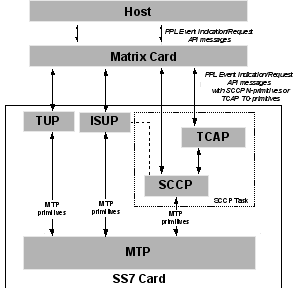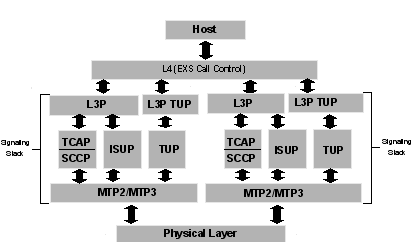
You are here: CSP Developer’s Guide: Common Channel Signaling > 2 Introduction to SS7 > SS7 Software Architecture

Overview
Cantata uses the PPL environment to implement the SS7 stack. This feature makes the stack modular and easy to customize. The SS7 software consists of the following modules:
• L3P
• ISUP
• L3P TUP
• TUP
• TCAP
• SCCP
• MTP
Each signaling stack must include MTP, L3P, and at least one user part. Selection of a specific module automatically uses the associated default PPL components.
Cantata implements BT IUP, a variant of L3P TUP. See TUP, BT IUP & SSUTR2, for an example configuration file and call flows for the BT IUP configuration. See SS7 PPL Information and the SS7 Signaling Stack Configure 0x5C for additional data on BT IUP.
Call control, circuit supervision, and maintenance can be managed using either the ISDN User Part (ISUP) or Telephone User Part (TUP) interfaces. The call control user part for a CIC is configured with the SS7 CIC Configure message.
SS7 Signaling Stack Integration
The figures on the following pages show how the SS7 Signaling Stack integrates into the CSP architecture. Default protocol component sets for each module are stored as part of system software and do not require downloading. Selection of a specific module automatically uses the associated PPL components.
Figure 2-3 SS7 Software Architecture (Single Stack)

Figure 2-4 SS7 Software Architecture (Multiple Stacks)

Layer 3 Plus (L3P)
L3P is an interface between Layer 3 Call Control (ISUP/TUP) and Layer 4 Call Control on the Matrix Controller, and Layer 5 (the host application). It also manages application-specific variants for call control.
L3P includes the following PPL Components:
• L3P CIC Control
Formats the presentation of SS7 data to and from the host and manages call control.
• L3P Link Management
Manages signaling links and formats presentations of SS7 signaling link control to and from the host.
• L3P Telephone User Part (TUP)
L3P TUP is an interface between Layer 3 (TUP), Layer 4 Call Control on the Matrix Controller, and Layer 5 (the host). L3P TUP formats information from Layer 3 into the programmed format for the host and host formatted information for Layer 3. It also manages application-specific variants for call control.
Integrated Services Digital Network User Part (ISUP) is the protocol for voice and non-voice services. ISUP includes the following PPL components:
• ISUP CPC (Call Processing Control)
CPC manages the call processing portion of ISUP. It manages both incoming and outgoing call setup and tear down.
• ISUP SPRC
SPRC acts as an ISUP message router. It validates and routes incoming ISUP messages to the correct ISUP state machine. It also sends outgoing messages to MTP.
• ISUP MPC/CSC (Maintenance Process Control/Circuit Supervision Control)
A collection of state machines that manage circuit maintenance, such as group blocking/unblocking and circuit reset.
|
Standard |
Component |
|---|---|
|
BLR, BLS, CCI, CRI, CGRR, CGRS, CRR, CRS, GBUR, GBUS, UCIC |
|
|
ITU-TS |
BLR, BLS, CCI, CGRR, CGRS, CRCR, CRR, CRS, HGBR, HGBS, HLB, HRB, MGBR, MGBS |
Telephone User Part (TUP) includes the following components:
• TUP CPC
CPC manages incoming and outgoing call setup and tear down.
• TUP SPRC
SPRC validates and routes incoming TUP messages to the correct TUP state machine. It also sends outgoing messages to MTP.
Message Transfer Part (MTP) is responsible for end-to-end reliable delivery of messages generated by its local user part (for example, ISUP). The MTP module comprises the MTP2 and MTP3 layers. MTP includes protocols and procedures to handle network failures and to dynamically reconfigure signaling resources to prevent message loss or duplication and out-of-sequence delivery.
MTP includes the following PPL components:
|
AERM |
RCAT |
TCRC
|
Signaling Connection Control Part (SCCP) provides both connectionless and connection-oriented network services above MTP Level 3. Transaction Capabilities Application Part (TCAP) provides transaction and remote operation capabilities to a large variety of applications distributed over the CSP and service centers in the network. Excel’s SCCP/TCAP development supports the following connectionless services:
• Specialized Routing
• Data Transfer
• Management Control
The following list contains the SS7 SCCP PPL components and their IDs:
0x65 SCLC - SCCP Connectionless Control
0x66 SCRC - SCCP Routing Control
0x67 SUSI - SCCP User Interface
0x68 SPPC - Signaling Point Prohibited Control
0x69 SPAC - Signaling Point Allowed Control
0x6A SPCC - Signaling Point Congestion Control
0x6B SSPC - Subsystem Prohibited Control
0x6C SSAC - Subsystem Allowed Control
0x6D SSTC - Subsystem Status Test Control
0x6E BCST - Broadcast
0x6F LBCS - Local Broadcast
The following list contains the SS7 TCAP PPL components and their IDs:
0x70 TUSI - TCAP User Interface
0x71 CCO - Component Portion Control
0x72 ISM - Component Portion
0x73 TCO - Transaction Coordinator
0x74 TSM - Transaction State Machine